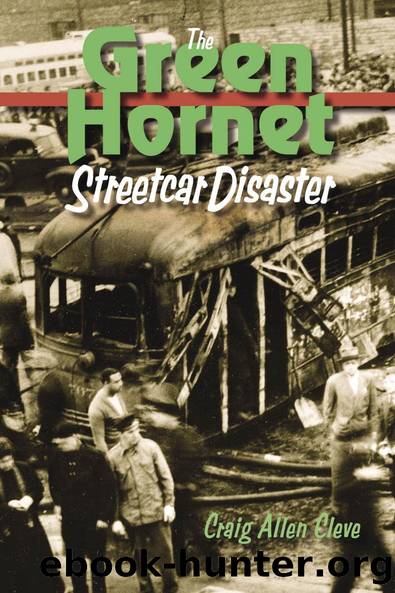The Green Hornet Street Car Disaster by Craig Allen Cleve

Author:Craig Allen Cleve [Cleve, Craig Allen]
Language: eng
Format: epub
Tags: History, United States, State & Local, General, Transportation, Public Transportation, Railroads
ISBN: 9781609090586
Google: ga28DwAAQBAJ
Publisher: Cornell University Press
Published: 2012-06-15T01:10:38+00:00
As CTA officials discussed Paul Manningâs actions, Mamie Manning did her best to defend her husband and answer some of the charges against him.
âTheyâre trying to put it all on Paul,â she told reporters. âTheyâre trying to lay this accident (on) him.â30
Reporters asked Mrs. Manning about the allegations that her husbandâs trolley was traveling at 30 miles per hour when it entered the switch. Her answer touched on a familiar theme.
âHe had to make his time. He always had to make his time. Well, now he has made it. They take off runs, and then they drive the men to make them keep their schedules. He was always harping on that. If they make their time, donât think theyâre not speeding.â31
Ray Medley, Manningâs brother-in-law, took a more practical position:
âWhy would he be going 30 mphâeven if he were going straight aheadâon a downhill grade ahead of him so near to Sixty-third Street, a dangerous intersection?â32
Medley was referring to the fact that Manning was less than 100 yards from his stop at the safety island just north of the intersection of 63rd and State streets. Near that point, State Street began its downward slope toward the viaduct.
âHe would have slid right across. He had to stop at Sixty-third.â33
For the first time, Medley suggested that Manning might not have been at fault.
âI heard talk down at the barn that he was supposed to be the first car to go throughâthat the water under the viaduct had receded enough. Did the flagman really wave him downâor wave him to go ahead?â34
Other motormen defended Manning when they complained that their schedules together with dense loads of passengers often made it necessary for them to speed. In the Chicago Sun-Times, on May 28, several motormen, conductors, and other CTA officials argued over the expectations regarding schedules.
One motorman, an eight-year veteran, said he and others ââ¦take chances we wouldnât take otherwise to keep a schedule. Anybody would have accidents at the speeds we have to go.â35
A conductor quoted in the same article said he sometimes feared for his own safety as motormen along his route did their best to make a 7½-mile route in 43 minutes.
âAny sane person would know that the speed of the cars should be cut.â36
Any act of God or minor traffic inconvenienceâbad weather, a long stop light, or a particularly busy corner with many boarding passengersâcould knock a motorman off schedule.
âThen we have to start taking chances. They keep after us to make the schedule.â37
CTA dispatchers, supervisors, and other officials interviewed for the piece took issue with the notion that schedules were expected to be kept at all costs. One official said that safety never took a backseat to schedules. He also disagreed with the motormenâs idea that they had to put on excessive speed to make schedules.
A dispatcher said he knew of no CTA directive compelling motormen to exceed the speed limit to stay on schedule. But he also said that with the new, smooth-riding Green Hornets, motormen might not even realize they were speeding.
Download
This site does not store any files on its server. We only index and link to content provided by other sites. Please contact the content providers to delete copyright contents if any and email us, we'll remove relevant links or contents immediately.
| Automotive | Aviation |
| History | Mass Transit |
| Owner's Manuals & Maintenance Guides | Railroads |
| Reference | Ships |
Small Unmanned Fixed-wing Aircraft Design by Andrew J. Keane Andras Sobester James P. Scanlan & András Sóbester & James P. Scanlan(32743)
Navigation and Map Reading by K Andrew(5111)
Endurance: Shackleton's Incredible Voyage by Alfred Lansing(4676)
And the Band Played On by Randy Shilts(2129)
Wild Ride by Adam Lashinsky(1933)
The Box by Marc Levinson(1931)
Top 10 Prague (EYEWITNESS TOP 10 TRAVEL GUIDES) by DK(1930)
The Race for Hitler's X-Planes: Britain's 1945 Mission to Capture Secret Luftwaffe Technology by John Christopher(1817)
The One Percenter Encyclopedia by Bill Hayes(1787)
Trans-Siberian Railway by Lonely Planet(1703)
Girls Auto Clinic Glove Box Guide by Patrice Banks(1684)
Bligh by Rob Mundle(1653)
Looking for a Ship by John McPhee(1630)
Batavia's Graveyard by Mike Dash(1607)
Good with Words by Patrick Barry(1602)
TWA 800 by Jack Cashill(1592)
Fighting Hitler's Jets: The Extraordinary Story of the American Airmen Who Beat the Luftwaffe and Defeated Nazi Germany by Robert F. Dorr(1591)
Troubleshooting and Repair of Diesel Engines by Paul Dempsey(1557)
Ticket to Ride by Tom Chesshyre(1543)
